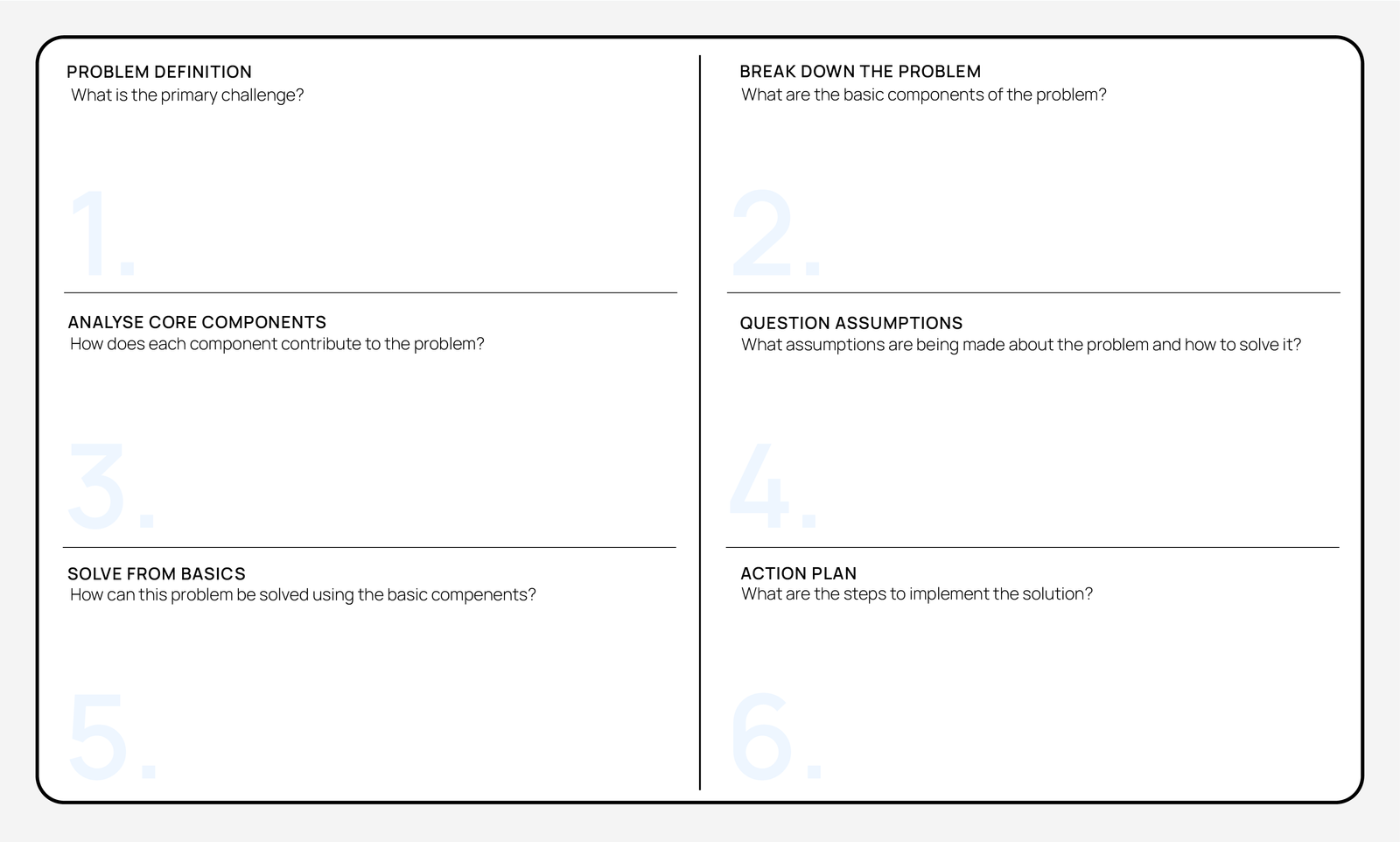First Principles
First Principles Thinking is a process that involves breaking down complex problems into their smaller, more manageable components to uncover fundamental truths. This approach helps to challenge existing assumptions, leading to innovative solutions.
Key concepts of first principles are illustrated below with an example of innovating space travel:
Fundamental Problem: The core issue is that space travel is costly, primarily due to the expensive process of building and launching rockets.
Core Components: To understand the problem, examine key cost factors such as rocket design, launch procedures, fuel usage, and material expenses.
Analyse Core Components: Determine which elements contribute most to the high costs. For instance, you might find that the costs are driven by expensive materials and the single-use nature of rockets.
Question Assumptions: Challenge the assumption that rockets must be used only once. Consider whether developing reusable rockets is feasible and would actually reduce costs.
Rebuild from the Ground Up or Reconstruct from Basics: Based on the insights, explore the feasibility of technologies that enable reusable rockets.
The results
- A clear understanding of the problem
- Innovative solutions that were not obvious before

When to use it
Innovative Problem-Solving: When seeking to develop innovative solutions
Complex Issues: When seeking to solve complex problems
Strategy Formulation: When seeking to build disruptive strategies
Strengths
Challenges assumptions
Encourages creative and unique approaches
Addresses root causes of problems
Weaknesses
Hard to apply in practice
Can be time consuming for proper examination
How to use it?
What do I need to start?
A problem definition.
How to use it?
Who to involve?
First principles can be done alone or with a team. Consider involving:
- People who have a deep understanding of the problem or aspects of the problem.
- People with diverse skills who can provide different perspectives on the problem.
- People whose feedback can help determine if the solutions developed are practical and meet real-world requirements.
Step by step
1
Identify the fundamental problem
Ensure stakeholders agree on the problem definition.
Focus on understanding the core issues rather than symptoms or secondary effects.
For example: If the problem is that manufacturing costs are too high to make building a product feasible, identify each cost component (materials, labour, overhead) and which components might be the primary problem.
Ask questions like:
- What is the primary challenge we are facing?
- Why is it important to address the problem now?
- How does this problem align with broader objectives or strategies?
2
Break down the problem
Decompose the problem into its most basic elements or fundamental truths. Ask questions like:
- What are the essential elements or parts of the problem?
- What are the primary causes or factors contributing to the problem?
- Are there any dependencies or relationships between different aspects of the problem?
- Can the problem be subdivided into smaller, more manageable sub-problems?
3
Analyse core components
Examine each basic element independently to understand its nature and relationships.
Determine how each component contributes to the overall problem and its potential solutions.
For example: Analyse the cost, availability, and performance of each material used in manufacturing.
Ask questions like:
- What are the characteristics of each core component?
- How does each component impact the problem?
- Are there any inefficiencies or opportunities for improvement in these components?
4
Question assumptions
Challenge existing assumptions, or established approaches.
Determine which assumptions are valid and which need to be reconsidered or discarded.
For example: If there is an assumption that a particular material is necessary for a product, question why that is the case and if alternatives exist.
Ask questions like:
- Are there any traditional approaches or methods that may be limiting the perspective?
- What assumptions are being made about how this problem should be solved?
- Have these methods or assumptions been thoroughly tested or validated?
- What evidence supports or refutes this assumption?
- What alternatives exist if this assumption is false?
- Are there any biases influencing current approaches to this problem?
5
Rebuild from the ground up or reconstruct from basics
Use the fundamental truths identified to reconstruct the problem from scratch.
Develop new solutions based on these basic principles rather than existing methods.
For example: If research indicates that a cheaper material can be used while still meeting end user needs, redesign your product to incorporate this material.
Ask questions like:
- How can I solve this problem using the basic components identified?
- Are there innovative solutions that haven’t been considered before?
- What new methods can be employed to address this problem?
- Are there new technologies that make a new approach feasible?
6
Action plan
Consider next steps and develop a plan to test potential solutions.
Consider outlining activities, resources and timelines. Project Initiation Documents (PID)’s can be useful